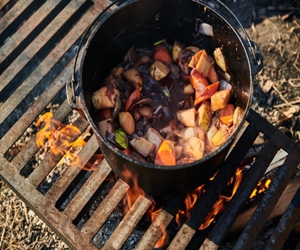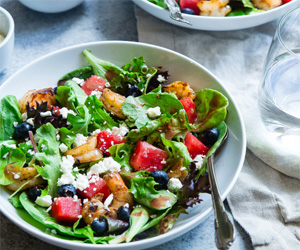


A Journey To Culinary Excellence

Cooking is a delightful fusion of science, art, and creativity, and the methods used can significantly impact the outcome of a dish. The world of cooking methods is vast and varied, with each approach offering unique advantages and applications. Whether you're an aspiring chef or a home cook looking to enhance your culinary skills, understanding various cooking methods is essential for creating mouthwatering dishes.
Dry Heat Cooking Methods
1. Roasting: Roasting involves cooking food in an oven or over an open flame. This method caramelizes the exterior while maintaining moisture within, resulting in tender, flavorful dishes. Roasting is ideal for meats, poultry, vegetables, and even fruits.
2. Baking: Similar to roasting, baking takes place in an enclosed oven. This method is perfect for bread, pastries, and casseroles, allowing even cooking and browning.
3. Grilling: Grilling imparts a smoky flavor and beautiful grill marks on food. It's a favorite for outdoor cooking, especially for items like burgers, steaks, vegetables, and seafood.
4. Broiling: Broiling places food directly beneath the oven's heating element. It's a quick way to achieve a browned and crispy top layer, making it ideal for cheese-topped dishes and meats.
Moist Heat Cooking Methods
1. Boiling: Boiling involves immersing food in boiling water. This method is suitable for pasta, rice, vegetables, and hardier foods. It's important to note cooking times to avoid overcooking.
2. Steaming: Steaming is a gentle method that cooks food over, not in, boiling water. It preserves nutrients and flavors, making it an excellent choice for vegetables, seafood, and dumplings.
3. Poaching: Poaching involves gently simmering food in a flavorful liquid, typically at a lower temperature than boiling. This method is perfect for cooking delicate items like eggs, fish, and chicken.
4. Simmering: Simmering cooks food in a liquid at a low, consistent temperature, creating a rich and aromatic broth. It's the foundation for soups, stews, and braised dishes.
Combination Cooking Methods
1. Braising: Braising combines dry and moist heat methods. Initially, food is seared in a pan to develop a crust, then it's simmered in a flavorful liquid. This method is excellent for tougher cuts of meat and vegetables.
2. Stewing: Stewing involves chopping food into small pieces and simmering them in a liquid to create a cohesive, flavorful dish. It's perfect for hearty, one-pot meals like stews and casseroles.
3. Sautéing And Stir-Frying: These high-heat, quick-cooking methods use a small amount of oil and frequent stirring. Sautéing is ideal for tender ingredients, while stir-frying is used for small pieces of food, often in a wok, producing crispy textures and intense flavors.
Specialized Cooking Methods
1. Sous-Vide: Sous-vide is a precise method of cooking food in vacuum-sealed bags submerged in a water bath at a consistent low temperature. It results in incredibly tender and evenly cooked dishes.
2. Smoking: Smoking involves exposing food to flavorful smoke, typically in a smoker or grill. It imparts a rich, smoky flavor and is often used for meats and fish.
3. Fermentation: Fermentation is a natural process used to transform foods and beverages. It's employed in making yogurt, cheese, beer, and sourdough bread.
Understanding cooking methods is an essential aspect of becoming a proficient cook. These methods offer a wide range of techniques to explore, each contributing to the overall flavor, texture, and visual appeal of your culinary creations. Whether you're grilling a steak, simmering a hearty stew, or trying your hand at sous-vide cooking, the methods you choose will determine the success and enjoyment of your dishes. Experimenting with various cooking methods is a rewarding journey that can lead to culinary excellence and gastronomic delights for yourself and others.






Techniques For Delicious, Safe Meals
 Separate Utensils: Use separate cutting boards, knives, and kitchen equipment for gluten-free cooking to avoid cross-contamination.
Separate Utensils: Use separate cutting boards, knives, and kitchen equipment for gluten-free cooking to avoid cross-contamination.
Clean Thoroughly: Ensure that surfaces and equipment are thoroughly cleaned before use. This includes cleaning countertops, oven racks, and utensils.
Label Ingredients: Clearly label gluten-free ingredients to prevent mix-ups, especially if you store gluten-containing and gluten-free products together.
Binding And Texture: Enhancing Your Dishes
Gluten provides structure and texture in many recipes. To mimic these qualities in gluten-free cooking:
A Flavorful Journey From Field To Plate
 Freshness: Farm-fresh ingredients are harvested or prepared at the peak of ripeness. This freshness imparts exceptional flavor and nutritional value to the food.
Freshness: Farm-fresh ingredients are harvested or prepared at the peak of ripeness. This freshness imparts exceptional flavor and nutritional value to the food.
Proximity: The journey from the farm to your plate is short, minimizing the time spent in storage or transportation. This close proximity ensures minimal loss of flavor and nutrients.
Minimal Processing: Farm-fresh ingredients are minimally processed, if at all. They retain their natural state and are free from the additives and preservatives commonly found in processed foods.
Transparency: The origins of farm-fresh ingredients are often transparent. Consumers can learn about the farming practices, visit the farms, and connect with the producers. This transparency builds trust and strengthens the farm-to-table connection.
A Culinary Journey Through Your Backyard
 Flavorful Benefits:
Flavorful Benefits:
One of the most immediate and compelling benefits of homegrown flavors is the enhancement of taste. Here are a few reasons why homegrown produce tastes better:
Ripeness: Homegrown produce is harvested when it's perfectly ripe, ensuring that you experience the fullest, most vibrant flavors.
Nutrient Density: The time and care you invest in your homegrown produce can lead to higher nutrient content, contributing to more intense and wholesome flavors.
Variety: You have the freedom to choose a wide variety of fruits, vegetables, and herbs that may not be available at your local grocery store, diversifying your palate.
Unique Varietals: Experimenting with different heirloom or unusual plant varieties can lead to exceptional and distinctive flavors that are hard to find elsewhere.
A Sustainable Choice: Homegrown flavors align with the principles of sustainability and environmental responsibility. When you grow your own produce, you reduce your carbon footprint, as there are no transportation or packaging requirements. Additionally, you have the flexibility to practice organic and eco-friendly gardening, reducing the use of harmful chemicals and conserving resources.
Understanding The Basics
 Bread And Baked Goods: Wheat-based bread, pastries, and cakes are rich in gluten.
Bread And Baked Goods: Wheat-based bread, pastries, and cakes are rich in gluten.
Pasta: Traditional wheat pasta is a gluten-containing staple.
Cereals: Many breakfast cereals are made from gluten-containing grains, though gluten-free alternatives are available.
Beer: Most beers are brewed with barley or wheat, making them a source of gluten.
Processed Foods: Gluten can hide in various processed foods, from salad dressings to sauces, and even some candies.
Pizza: Pizza crust is traditionally made from wheat dough, but gluten-free options are widely available.
Flour And Breading: Flour derived from wheat is used for breading, thickening, and in baking.
Health Considerations
For the vast majority of people, gluten-containing foods are a safe and nutritious part of their diets. However, for those with celiac disease, an autoimmune disorder, consuming gluten can have severe health consequences, as it triggers an immune response leading to damage in the small intestine.
 Hydration And Digestive Health
Hydration And Digestive Health
Staying hydrated is vital for overall well-being, and juices offer a hydrating solution with a nutrient boost. Additionally, many fresh juices contain dietary fiber, which supports healthy digestion and can promote a feeling of fullness.
Convenience And Customization
One of the key advantages of nutrient-rich juices is their convenience. Whether you're in a rush in the morning, need a midday pick-me-up, or want to complement your meals, a fresh juice is a quick and accessible option. Moreover, you can customize your juice to suit your taste and nutritional needs, ensuring that you get the nutrients that matter most to you.
A Multitude Of Varieties
Nutrient-rich juices come in a wide array of flavors and combinations. You can enjoy classic choices like orange, apple, or grape juice, or explore more adventurous blends like a detoxifying green juice with kale, cucumber, and ginger. The choices are almost limitless, and experimenting with different ingredients can be both fun and rewarding.
The Power Of Essential Vitamins
 Vitamin E (Tocopherol): As an antioxidant, vitamin E helps protect cells from damage and supports skin and eye health. It's found in nuts, seeds, and vegetable oils.
Vitamin E (Tocopherol): As an antioxidant, vitamin E helps protect cells from damage and supports skin and eye health. It's found in nuts, seeds, and vegetable oils.
Vitamin K (Phylloquinone): Vitamin K is essential for blood clotting and bone metabolism. Dark leafy greens and broccoli are rich sources.
The Importance Of Balanced Vitamin Intake
Balancing your intake of essential vitamins is critical to maintaining overall health and well-being. An unbalanced diet that lacks these essential nutrients can lead to vitamin deficiencies, which are associated with a variety of health issues. On the other hand, excessive intake of some vitamins can have adverse effects. Striving for a varied diet that includes a wide array of nutrient-rich foods is the best approach.
Supplements: A Complementary Strategy
In cases where dietary intake of essential vitamins is insufficient or when specific medical conditions or dietary restrictions apply, supplements can be a valuable addition to your routine. However, it's important to consult with a healthcare professional before starting any supplementation regimen to avoid overconsumption, which can be harmful.